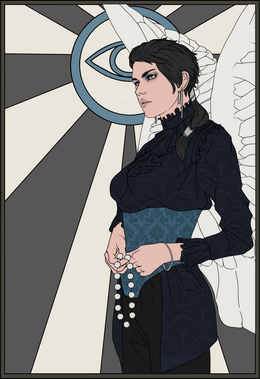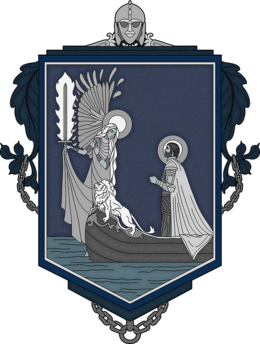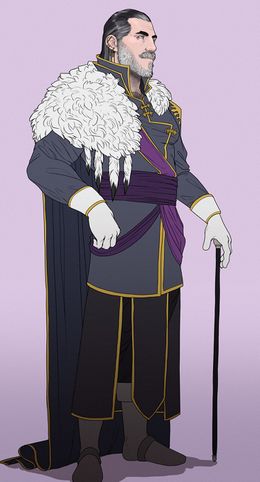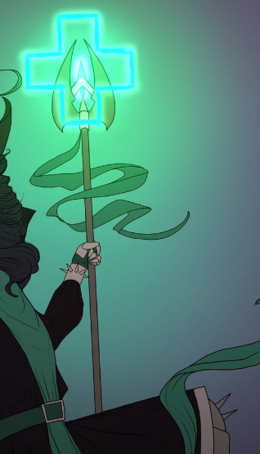Aelrrigan Order: Difference between revisions
No edit summary |
No edit summary |
||
| Line 62: | Line 62: | ||
* '''The Grandmaster''' (NPC) is the highest leader of the Aelrrigan Order. | * '''The Grandmaster''' (NPC) is the highest leader of the Aelrrigan Order. | ||
* '''The Elder Council''' (NPC) are the elders and mentors and teachers of the Order. | * '''The Elder Council''' (NPC) are the elders and mentors and teachers of the Order. | ||
* '''The [[Mage-Knights]]''' (NPC) are the Order's strongest Mages | * '''The [[Mage-Knights]]''' (NPC) are the Order's strongest Mages, Knights of fabled power. | ||
* '''The NAME-Knights''' (Player) are the highest attainable rank of Knight of high prestige and esteem. | * '''The NAME-Knights''' (Player) are the highest attainable rank of Knight of high prestige and esteem. | ||
* '''The NAME-Knights''' (Player) are well respected Knights with great sway in the Order. | * '''The NAME-Knights''' (Player) are well respected Knights with great sway in the Order. | ||
Revision as of 21:02, 29 August 2023
| Aelrrigan Order | |
|---|---|
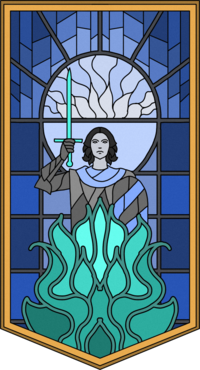 | |
| Order | |
| Pronunciation | Ail-ree-gan |
| Origins | Kintyr |
| Grandmaster | Ffiontirre of Wythwaite |
| Symbols | Unionist eye, flaming sword, feathered wings |
| Colors | white, dark gray, sky blue |
The Aelrrigan Order is a Knightly Order primarily occupied with fighting the negative effects of Magic on the world, though by harnessing and teaching as opposed to repressing and peaceful cleansing instead of eradicating. Among the Aelrrigan Knights, Magic usage is very common, and they even provide safe ways to teach responsible Magic usage to others. Inversely however, the Aelrrigan Order has some of the most ruthless Mage-Hunters who track down what they call Renegade Mages (sometimes also called “Goz” for the Breizh word for mole, or just Renegade). Beyond their enforcement of responsible and moral usage of Magic, the Aelrrigan also hunt down Artifacts of Magic in order to keep them out of the hands of the common people, and lock them up into a fortification called an Enemohér, which those who speak Common often refer to as a Magi-Vault or Mohér. The Aelrrigan ply their craft somewhere between the laws of the land and their own moral codes, never quite being fully recognized and legalized in the same way the other Knight Orders had been, but still finding ways to fulfill their divine mission. The Aelrrigan follow the Marvdeiz Diougan, which is loosely translated to the Doomsday Prophecy in Common, an extremely rare instance of three religions all convening for a common goal and concept, to warn the world about dangers and instructing their followers on what to do about it.
Design
The Aelrrigan Order is a Knightly Order that specializes in positive enforcement of good Magical conduct on the people of the Empire. Aelriggan Chapter houses are some of the few rare locations in the Regalian Empire where one can learn Magic and be taught Magic by practicing teachers without requiring extensive paperwork and documents to prove legality. The Aelrrigans teach their students ethical magic usage, not to treat magic like a toy, to be respectful, and to only use it when necessary and not overly self indulgent, and to guard the mind and soul from Demonic corruption. The Knights of the Aelrrigan Order also hunt Renegade Mages who use Magic to harm and corrupt, perform kangaroo courts, and punish those who court evil with Magic. Their final task is also to secure wayward Artifacts and keep dangerous Magical objects out of the hands of the common folk who do not understand such terrible power. With regards to Occult Status, the Aelrrigan Order is primarily Occult and Non-Occult, allowing both Void and Exist magic usage. However, the Aelrrigan Order does not induct or allow Ordial Mages.
Order Chapters
(just put the lothar one here as template, the aelrrigans have never had chapters) The Lothar Order is not one unified group but consists of Chapters. It is made up of Tirgunn based Darkwalds, Calemberg based Grauwalds, Krainivaya based Krsnik, Girobalda based Herebrand, and Nordskag based Randbane. Choosing one is mandatory and affects roleplay, as each group acts slightly differently, and groups like Grauwald have specific functions within the Lothar Order that are not shared by the other two Groups.
- The Darkwald Group: Darkwalds are extreme radicals who have unlimited hatred for the Afflicted, and whose entire life is dominated by the hunt and execution of them.
- The Krsnik Group: Krsniks are more religious and Emperor faithful, taking a more priestly approach but still excising the evil they think has gripped society.
- The Grauwald Group: Grauwalds are more pragmatic, bellieving that until all Magic can be removed, Magic is like fighting fire with fire and should be used as tools.
- The Herebrand Group: Herebrands believe in more frontline fighting, calling upon crusader knight aesthetics with heavy armor and sword and shield.
- The Randbane Group: Randbanes are Velheim purists who specifically specialize in the fighting of Arken plots and designs, but are more tolerant of Magic.
Why Play a Knight
Knighthood is a good way to get involved in pre-existing groups and activities. Since it guarantees roleplay, a group, and a reason to log on, it is appealing for everyone from new players to veterans. Knight groups organize their own internal social roleplay and are usually well-received by the player base as pleasant spaces. Knighthood also grants a unique ranking system for Characters to progress up the ladder of their Order and gain privileges for honesty and effectiveness in their Code. Knight roleplay requires reading, however, as Knight characters must follow their Codes or risk expulsion. Aelrrigan Knighthood is recommended for players who want to play a Magic Knight with high fantasy aesthetics, the defender of the Occult from reactionaries who want to oppress them, but also teachers of restraint and wisdom in Magic use who hold accountable those who twist Magic to flippancy and evil.
Knights Code
Common Knights Code
All Knights of all Orders are beholden to this Knights Code.
- Knights are expected to be loyal to the Emperor and the Empire without complaint. Unionism is not required, but obedience to the Crown is.
- Knights are expected never to attack the unarmed and defenseless, and to not resort to dirty fighting tricks or attack others from behind.
- Knights are expected not to complain, moan, or self-deprecate, Knights should never degrade themselves or be an annoying bore.
- Knights are expected to follow the laws of the land and not become a Criminal. They should assist Guards in apprehending criminals.
- Knights are expected to enforce the Law, but must hand Prisoners over to Constables immediately, and cannot be involved in Prison processes.
- Knights are expected not to lie, but never express every truth that needn’t be known. Knights should not deceive unless for the greater good.
- Knights are expected to give alms to the poor and care for the needy, and to protect those who cannot protect themselves, and punish dishonor.
Specific Order Code
The following Knights Code applies only to the Aelrrigan Order.
- Aelrrigan Knights are expected to jump to action immediately upon the first sighting of a Void or Exist Conduit, and fully cleanse it to prevent calamitous and cancerous dimensional diseases from breaking out. Only they can do this, as Conduits are much more powerful than just normal area based corruption, though these may only appear in Events, Progressions, or implied in Lore Stories.
- Aelrrigan Knights are expected to morally or vocally combat repression or mal-treatment of the Occult for the sake of being Occult. This does not mean that Aelrrigans attack anyone who attacks a Mage, merely that they will argue for a reduction in repressive policies. If however a person is being abused just because they happen to be an Occult and are harmless, Aelrrigans are expected to step in.
- Aelrrigan Knights are expected to assist in the cleansing of Afflicted individuals where possible, and to lecture those that use Magical Mutation and Corruption for aesthetic purposes that there is real danger in simply corrupting the body with Magic unchecked. Aelrrigans are expected to keep up to date on the Magical happenings around the world and express the dangers of them to those investigating them.
- Aelrrigan Knights are expected to constantly evaluate the population of so-called Renegade Mages. If they in Meet to (a conference to vote) decide that a Mage is considered Renegade, they must try to capture and imprison them. The first time a Renegade Mage is captured, the Aelrrigans hold a kangaroo court to chastise them, go over their harm to society, and send them off with a final warning. Further mis use leads to another trial wherein Elen is called upon to sever the Mage's connection and thus break their Magical Powers.
- Aelrrigan Knights are expected to hunt down Demons, Spirits, or any other form of corrupted or lost soul or body inhabited by a Void, Exist, or Beyond born entity and purge any and all that are found. They must also cleanse areas infected with Void or Exist Essence and prevent civilian interaction. Aelrrigans however don't have sole right to cordon off an area, and are expected to work with the Metropolitan to secure a crime scene or dangerous area.
- Aelrrigan Knights are expected to administer the Danna Magica (Artifact Law) as outlined by the Aelrrigan Order (see section below). Furthermore, Aelrrigan Knights are expected to defend Aelrrigan Magivaults or Mohér as it is called.
- Aelrrigan Knights are expected to make themselves available to teach Magic to anyone willing to learn, but to also impress the Aelrrigan moral fabric onto them, to use Magic for healing, defense and aid, and never for greed, pleasure, or unwarranted violence on others. They should also punish and persecute any of their own students who misuse Magic, and chase after other Magic teachers to ensure they also teach the right moral code.
Renegade Mages
Renegade Mages are a concept unique to Aelrrigan Knights, that has some nuance to it in how they are judged and approached. While many groups and societies label Mages as wholesale dangers, Aelrrigans have a strict set of specifications by which they decide if a Mage is a danger to society and the health and wellbeing of the people around them. These people are labeled Renegade Mages after deliberation by the Aelrrigans, wherein they assess if the Mage is actually a threat, or is just misguided. Most importantly, the Aelrrigans must self-reflect on if the Mage is simply a personal nuisance to them, as while Aelrrigans spend most of their time defending the Magi-Vault, the Magi-Vault is expressly an institution that exists outside of society, by design, so Mages who frequently try to steal Artifacts from it are not Renegade by default. If a so-called Renegade Mage is captured and given their first Trial, the Aelrrigans go through their crimes, and how to repent and change, sending the Renegade Mage off with a final warning. Following this first trial, they are no longer expressly considered a Renegade Mage, but the Aelrrigans are expected to generally keep a close eye on them. Mages who do not change their ways, and continue to cause harm to society at large are labeled a "Stage-Two" Renegade Mage, which is the point at which the Aelrrigans decide that the only way to deal with them is to sever their magic. The Aelrrigans then issue an internal capture warrant, and seek to contain the Renegade Mage and drag them to the Magi-Vault for a final Trial, wherein, if they are found guilty (they almost always are), Elen is called upon to sever their magic. This process is irreversible without Godly intervention, and marks a significant second-chapter of the person's life, adjusting to living without magic.
Danna Magica
Danna Magica, which is Breizh for Artifact Law, is a collection of written expectations and behaviors that dictate how Aelrrigans must interact with Artifacts in circulation among the population. Regalia has (always) had a fairly loose law concerning Artifacts, cognizant of the fact that many nobles see them as something prestigious to own, and Mages see them as powerful boons to use, but not feeling motivated enough to get involved in the infrequent fighting over these powerful objects (and not wanting to be responsible for the collateral damage). As such, the Aelrrigan Order has effective free range to apply their own laws over Artifacts and enforce them, even if they are not recognized as State Laws, and the State Metropolitan cannot assist them in their duties for them. A lot of these rules are circumstantial, so they should be read in order.
- When a new Artifact appears in Regalia, the Aelrrigans are expected to hold a Meet to discuss the implications. They should before the Meet: investigate where the Artifact is from, who made it, what ideology it represents, what the providence of the artifact is (who used to own it), how it was used in the past, and how it is likely to be used in the future. It would be even better if they can convince the artifact owner to show up at the Meet to declare their intent, but refusing to show up at the Meet may also be counted as evidence to the Artifact's morality.
- When the Meet takes place, the Aelrrigans (or those who could show up), are expected to evaluate the morality of an Artifact (ideally detached from the current owner, but owners also matter), whether it holds "evil intent" or "righteous intent", and come to some kind of consensus between the two (if an Artifact is righteous, but is always owned by evil people, it can still be declared of evil intent and vise versa). This decision is not permanent, any Aelrrigan may call another meet to re-consider an Artifact's designation at a later time.
- When an Artifact has been declared with "righteous intent", the current owner is considered to have been granted permission by the Aelrrigan Order to keep the Artifact so long as the Aelrrigans can keep an eye on the usage of it. Should the Artifact pass into the hands of a new owner, it is up to the Aelrrigans to quickly agree to: Do nothing, assist the previous owner in taking it back, or approve the new owner as holding the artifact "with righteous intent", thus declaring the previous owner as no longer legitimate in their eyes.
- When the Artifact has been declared with "evil intent", the Aelrrigans are all called upon to seek out the owner, and retrieve the Artifact by whatever means necessary, be it diplomacy, violence, or deception. When an Artifact has been retrieved, the Aelrrigans must decide if they want to safeguard it themselves, or hand it off to someone they beleive can utilize it, or at least protect it, with "righteous intent."
- Artifacts, to the Aelrrigans, are not considered necessarily evil by default, but the vast majority of the people in the city of Regalia do not have what it takes to protect an artifact from evil will and deeds, according to the Aelrrigans. Artifacts can cause a lot of damage, or even inspire others to cause a lot of damage, and especially the Void, Exist, and Ordial ones, have the capacity to cause a Conduit to occur if handled inappropriately or destroyed somehow. Aelrrigans are Artifact police, so it is up to them to decide which one is legal or not, and how.
Structure
The Aelrrigan Order has a hierarchical structure that defines ranks within the Order:
- The Grandmaster (NPC) is the highest leader of the Aelrrigan Order.
- The Elder Council (NPC) are the elders and mentors and teachers of the Order.
- The Mage-Knights (NPC) are the Order's strongest Mages, Knights of fabled power.
- The NAME-Knights (Player) are the highest attainable rank of Knight of high prestige and esteem.
- The NAME-Knights (Player) are well respected Knights with great sway in the Order.
- The NAME-Knights (Player) are the esteemed warriors sent on difficult tasks for the Order.
- The Wydd-Knights (Player) are the formal rank of Knights who get sent on missions.
- The Ward-Knights (Player) are the lowest rank of just-graduated Knight in the Order.
- The Squires (Player) are pre-graduation. Recommended for trying out, with less obligations.
Privileges
Privileges are a set of unlockable rewards that can be attained each time a Knight ranks up. The rank up process is evaluated by Lore Staff based on a combination of: adherence to the lore, adherence to the knight's code, activity, consistent character portrayal, good engagement and in some of the higher ranks, leadership. When a rank up is granted, players may choose one of these privileges (each only once) to apply to that rank up, ensuring that the appropriate reward is granted for each milestone. Being expelled from the Order causes the loss of all Privileges, and in some cases, Privileges may also be revoked if a Character is punished by the order for misdeeds, or disciplined by staff for Server Rule breaking.
- Privilege 1 The Knight in question becomes immune to Affliction Infection, Markenism, Thralling, and Persuasion Rolls.
- Privilege 2 The Knight in question is granted a rent-free Knight's Estate in the Knight Quarter with Staff decoration.
- Privilege 3 The Knight when dying, becomes a God Magic Remnant Spirit (using Spirit Traits), which can be revived for 1 Divinium.
- Privilege 4 The Knight in question may consult the Sarnan Archive and Darkwald archive of Afflicted Knowledge.
- Privilege 5 The Knight in question receives an Artifact designed for their Character that cannot be taken from them.
History
Aelrrigan Order history is closely linked with Breizh cultural history, as its founding location was the Kintyr lands in the Regalian Archipelago. Its foundation is linked to the Marvdeiz Diougan, a term that is loosely translated to Doomsday Prophecy, but rather than a set of tenets and beliefs, it actually refers to a highly unusual meeting and the events that came as a consequence of that meeting. To understand the event however, it is important to understand the context in which it took place. Kintyr at the time was one of the most divided but also populous regions in the Regalian Archipelago, which was nonetheless troubled by the Elven slave raids in the surrounding lands. Kintyr was unable to properly unite a common force against the foreign invaders because their land was so bitterly divided over religion. In almost equal numbers, the Breizh people were Dragon Worshipers of Regulus, Old Gods followers of the Vanir and Aesir, and held a unique religion called the Weards of Elen, with all three religions making up roughly a third of the total population and splitting it three ways. An often unspoken about topic that also bothered them, were the Void Conduits. A Conduit happens when a large amount of Void Magic or Exist Magic converges in an area to saturate it to such a degree that it becomes cancerous to anything living in the area, and rots anything that comes in contact with it. Void Conduits happened more and more as the world came closer to the Void Invasion, though obviously the denizens of the world did not yet know it was coming. These Void Conduits manifested all over the Regalian Archipelago but also in Kintyr, because of the rampant Magic usage halfway across the world in the Allorn Empire.
The Marvdeiz Diougan refers to a meeting of the three religions in the Fields of Dánna. First came the dragon Regulus assuming Ailor form with long black hair, silken robes and purple eyes. Second came Elen, white feathered wings with songs of the fae from the clouds. And third came Odal and Adal, riding a long thunderous strike. The meeting is well recorded, because the faithful took effort to announce this coming meeting ahead of time, meaning hundreds if not thousands of people were present to witness it from all faiths. During the Marvdeiz Diougan each divine representative of their religion made a verbal agreement and demand of the Kintyr people to set aside their religious differences, and unite against the threat of the Void Conduits, which were causing a plague on the land called the Black Mould, a high contagious disease that was caused by inhaling Void corrupted spores, with guaranteed fatality. The divine entities made it abundantly clear that this unificiation was necessary, to prevent utter calamity. This event is exceptional for each religion even, as Dragons were not known to interact this much with their own worship which they often disregarded, and it is also the only recorded time in history when gods of different religions were present in the same area, let alone preaching a common goal.
Each of the divine beings demanded a unified effort on the part of the Breizh people, to form the Aelrrigan Dathonair, the forerunner of the modern Aelrrigan Order. Each of the royal houses (which would later become the Ducal houses as petty Breizh royalty wasn't the same as Imperial royalty) swore fealty to the Dathonair, giving their second born sons up to the Order to be guided by the Gods. In return, the Gods taught the Dathonair the complex and dangerous rituals involved in cleansing the Void Conduits, calling upon a mixture of Dragon, Old Gods, and Wearden powers to bring a halt to the Black Mould plague that was sweeping the region. It is mostly this event and subsequent formation of the Dathonair that modern scholars credit as the reason why nobody really remembers just how awful the Void Conduits were, as they were so successful, that after 200 years, there were no Void Conduits left. Some even dare speculate that because the Dathonair cleansed the lands, by the time Cataclysm happened (which in itself was a very destructive magic-caused event) there wasn't enough magical energy on the Archipelago for the Cataclysm to erupt like a catalyst, thus preventing any major natural disasters in the area and setting up the Regalian Empire with an easy start five years later.
The Dathonair continued their work even into the founding of the Regalian Empire. The Wearden of Elen as a standalone religion would soon cease to exist, as the Concilly Council incorporated the Wearden into Dogmatic Unionism during the first schism, after which the second Emperor of Regalia re-confirmed the commitment of the Everwatcher to uphold the pact made by the Elen during the Marvdeiz Diougan. In essence, Unionism took over the responsibility of the Wearden of Elen, as Unionism replaced said religion, while Dragon Worship and Old Gods worship remained in place, with various priests of both religions also ratifying the succession of Unionism which holds more or less to this day. With the Empire's somewhat loose attitude to Magic early on, the Dathonair were able to continue doing their work, but also found because of their efficiency, that little work had to be done. This in turn invited complacency among Regalian officials about the need of the Dathonair. This came to a head roughly 70 years after the first Unionism Schism, when anti Evintarian sentiment and the concept of magical mutations and evolutions gave rise to strong purist sentiments.
The dark times for the Dathonair truly set in, in 100 AC, when Arch-Chancellor Maenarra peaked anti-Magic Regalian sentiment with the creation of the Azure Order, allowing Grand Vigil Nicholas to implement his anti-Magic reforms. A true purge followed where many non-Magi signed up to the Azure Order and spread out across the Empire to hunt down Magic users, including Dathonair Mage-Knights. Many of the Dathonair Sanctuaries and Chapter houses were burned, with the Knights slain or imprisoned in the Azure Spire in the City of Regalia. Few of the Order survived without being captured, and most of the Bayor tapestries recording the history of the order were lost, or hidden away and soon forgotten as their protectors were slain elsewhere and taking their location with them to the grave. In 140 AC, the Azure Order declared the Dathonair destroyed, with the burning of Grandmaster Robwyn of Coltyr, being the last captured Dathonair who hid away in the mountains of Alstyr in Kintyr.
The spirit of the Dathonair was kept alive by those proud Ducal families who had once been the first to pledge their allegiance nearly 1200 years prior, hiding their bayor tapestries that recorded the codes and conduct of the Dathonair. They even kept alive knowledge of the rituals and artifacts used to cleanse Conduits, even though none of them were actually trained how to use them. It is during this time that some Old Gods and Dragon Worshipers blame Unionis for radicalizing and breaking the Marvdeiz Diougan, but reality is far more complicated. By this time, Dragon Worshipers had also soured on Mages, with the notable Gray Witches in Anglia becoming extremely xenophobic towards magic users and infected, refusing to even cure simple magical ailments. Similarly, the Old Gods worshipers in the region had been dealt a heavy blow by magic using Solvaan who supported the Regalian Empire in the Skagger wars, thus increasing anti-magical sentiment (also because Elves were very popular among the Dathonair, and commonly lived in Kintyr also). With the death of all Dathonair and the loss of know-how to destroy Conduits, the Azure Order that once hunted the Dathonair now turned their destructive means on the Conduits, causing a lot of collateral damage in the process as they started appearing more and more as time passed further since the death of the last Dathonair.
It was however Unionism that also breathed life back into the compact, during the reign of Emperor Justinian II. Emperor Justinian along with the succeeding Kade dynasty, would later be known as the People Realists, or ruling entities that were more aligned with the needs of the people, than the needs of the Nobility. In doing so, Emperor Justinian II became acutely aware of the effect of Azure cleansing on the people. Far from the Dathonair cleansing rituals of old and the healing of the local population, the Azure Order would call down an extermination order on areas which housed Void Conduits, using cannons and explosive barrels to turn the area into a massive crater, thus denying the Void any matter to hold onto, while also hunting down any person who would have come close to the Conduit and putting them to death as a precaution for Void Demon infestation. This had a huge toll on the local population, and turned sentiment against the Azure Order at large.
Despite severe protests from the Azure Order, the ban on the Dathonair was rescinded by Emperor Justinian II in 270 AC, which immediately resulted in the Conclave of Coltyr, where all the major Ducal families brought the remnants of what they had hidden of the Dathonair together, and re-founded the order. This time, to distinguish it from the past, it was referred to as the Aelrrigan Order, leaving the history of the Dathonair in the past. The struggle over influence between the Azure Order and the Aelrrigan would continue until the former's destruction at the hands of the Deathling Occupation. Emperor Alexander I simply never renewed the charter for the Azure Order, and as such, the Aelrrigans had essentially outlived their foe, and were free to formally exist as a Knightly Order without organizational enemies, who would nonetheless later re-appear as Lothar Knights.
Trivia
- Nobles who are Aelrrigans permitted to hold a title, but must always be referred to as Lord-Protectors instead of any other titles.
- Elen, the Lady of Rivers, Goddess of Unionism is not an Aelrrigan Knight, but has frequently been sighted in cooperation with them when chasing after a particularly nasty Renegade Mage who has run rampant.
- Elen, the Lady of Rivers, is also responsible for disabling a Renegade Mage’s Magical connections when and if they are captured. She is summoned to a trial of a Renegade Mage to cleanse their Magic if they are found guilty.
- While the Aelrrigan Order has a Grandmaster, the Grandmaster is merely ceremonial. The actual power is rested in the mysterious and terrifyingly powerful Mage-Knight Elders.
- Regalia used to have a Magi-Vault, which housed a large number of Artifacts, but it was destroyed cataclysmically by Arken in 311 AC. Aelrrigans in Regalia are expected to safeguard Artifacts themselves.
- While the Order does not allow Broods to be trained as Squires and Knights, they instead offer them tutelage and work as Scribes, Messengers, and the Bureaucrats of the Order. They are well protected with "low stakes" duties to dissuade them from giving in to their afflicted urges.
| ||||||||||||||||||||||
| Accreditation | |||||||
|---|---|---|---|---|---|---|---|
|
| ||||||
